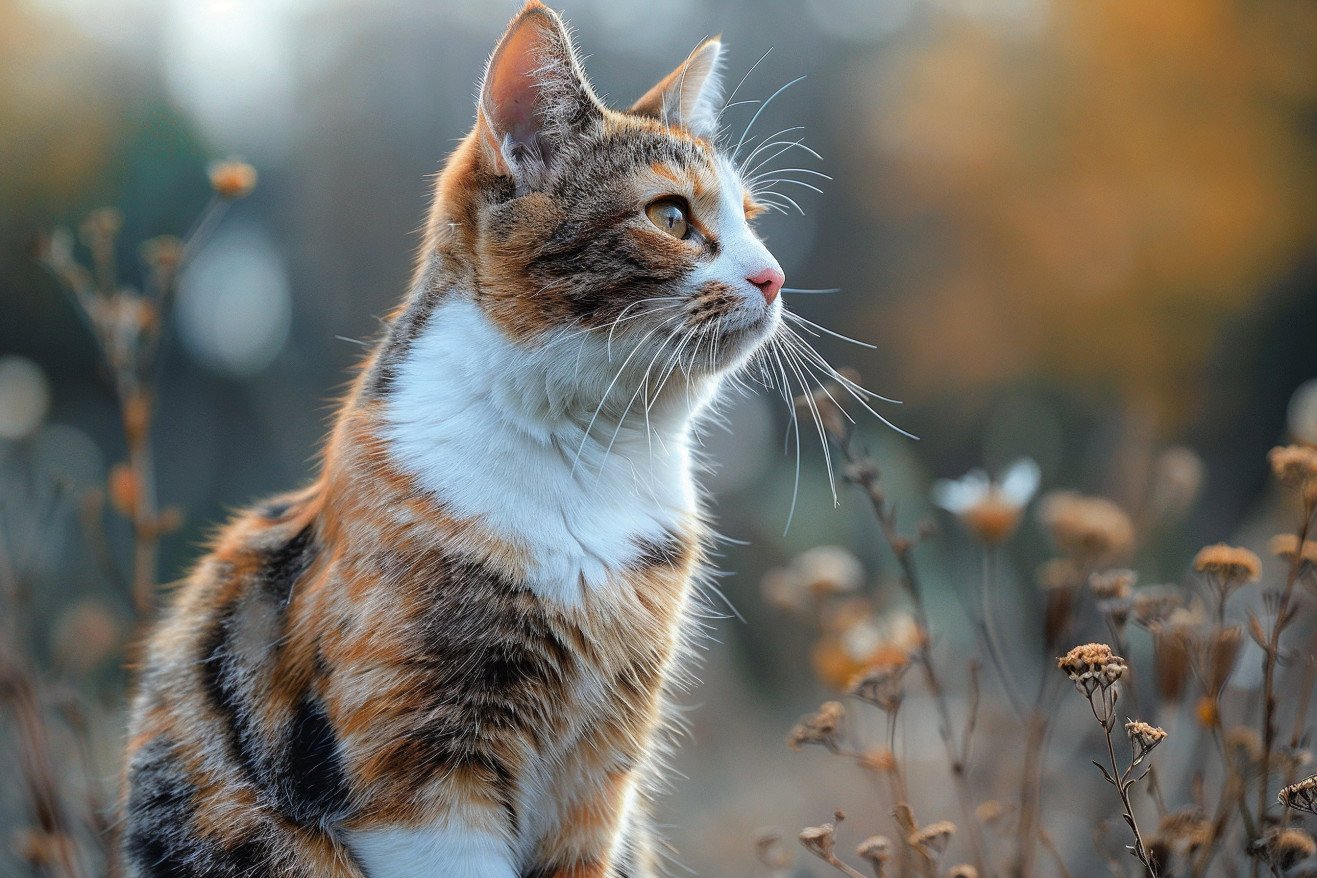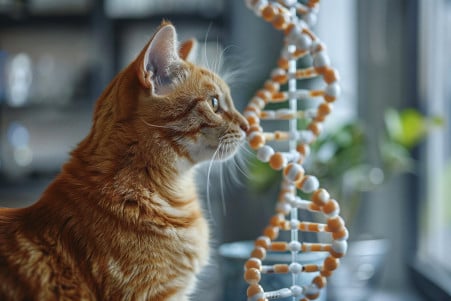The Genetics of Male Calico Cats: An Anomaly of Science
22 March 2024 • Updated 21 March 2024

Calico cats are famous for their beautiful, tri-colored coats, but the chances of a male cat being a calico are very slim due to the genetic factors that determine their coat color. The calico cat's coloration is the result of an unusual expression of the X chromosome. Since males only have one X chromosome, the mutation required for a calico pattern is extremely unlikely, occurring in only 1 out of every 3,000 calico cats—making a male calico cat a true feline rarity.
To understand the biological reasons for this, we will explore the genetics studies that have helped us understand why male calico cats are so rare. This will not only help us understand the genetics of cat coat color, but also the genetic factors that determine observable traits in other species. This knowledge will help you appreciate the biological factors that make male calico cats unique and explain why evolution has led to their beautiful, but rare, coats.
Why is it unusual for a calico cat to be male?
Genetics of X-Chromosome Inactivation
The calico cat's unique coat is a result of a basic genetic process called X-chromosome inactivation (XCI). As the Nature's Scitable blog explains, female mammals have two X chromosomes, one from each parent. However, to keep the gene dosage between the sexes equal (since males only have one X chromosome), one of the X chromosomes in each cell is inactivated at the start of embryonic development.
This inactivation leads to a mosaic pattern of cells, some of which express the orange fur color allele from the mother's active X chromosome, and some of which express the black fur color allele from the father's X chromosome. As Frontiers for Young Minds describes, it's the random inactivation of the X chromosome in different cell populations that leads to the calico's distinctive pattern of orange and black patches in its fur.
XCI evolved as a dosage compensation mechanism to equalize the levels of X-linked gene products between XX females and XY males. Otherwise, females would produce twice as many transcripts from X-linked genes as males, according to BioInteractive.
The inactivated X chromosome forms a condensed, heterochromatic structure called the Barr body within the nucleus. Nature's Scitable points out that most of the genes on the inactivated X chromosome are silenced by epigenetic modifications such as DNA hypermethylation. However, the inactivated X chromosome is reactivated during oogenesis (egg production) to ensure that the developing embryo has the correct gene dosage.
This unusual genetic process not only explains the calico cat's coloring, but also has broader implications.
Understanding Male Calico Cats: Unraveling Klinefelter's Syndrome
Because the genetic mutation that leads to calico cats is tied to the X-chromosome, male calico cats are almost always born with an extra X-chromosome. This condition is known as Klinefelter's Syndrome and is associated with a number of health problems.
In addition to cognitive and behavioral issues, male calico cats with Klinefelter's Syndrome are more likely to have weak, brittle bones that are more prone to breakage. In fact, The New York Times reports that male calico cats with Klinefelter's Syndrome are almost always sterile and cannot be used for breeding. Moreover, ASPCA Pet Insurance explains that the extra body fat that comes with Klinefelter's Syndrome can lead to a number of health problems, including joint pain, heart disease, and diabetes.
While male calico cats with Klinefelter's Syndrome can live long, happy lives, they may need special care and treatment to help them manage their health issues. In fact, Pet Insurance Review explains that male calico cats with Klinefelter's Syndrome have a shorter lifespan than female calico cats. As a result, it's important to understand the genetic mutation and its associated health problems to ensure that male calico cats receive the care they need to thrive.
How to Find and Buy a Male Calico Cat
Male calico cats are extremely rare, with only about one in every 3,000 calico cats being male, but they can be easily identified by their tri-color fur. As explained in the Wikipedia article on calico cats, the calico pattern is caused by the random inactivation of one of the two X chromosomes in female cats, which leads to a patchwork of cells with different fur color genes. For a male cat to have this coloration, it must have an extra X chromosome, a genetic condition called Klinefelter syndrome.
To confirm the sex and genetic makeup of a cat suspected of being a male calico, a physical examination and genetic testing would be necessary, according to the Yahoo Sports article about the rare "Unicorn" kitten. Because of their rarity, male calico cats may also be more expensive to buy from breeders than female calicos.
However, people looking to adopt a male calico cat may have better luck at animal shelters or rescue groups, as was the case with the story of "David Bowie" - a 4-year-old male calico cat who was adopted from a shelter run by the Indiana Humane Society. These rare cats have captured the public's attention, and the media attention given to male calicos like "Unicorn" and "David Bowie" has drawn attention to their specialness.
Mating and Reproduction of Male Calico Cats
Although it has long been assumed that male calico cats are sterile and unable to reproduce, recent studies have shown that this is not always the case. According to Mehedi Masum on Medium, chimerism, or the presence of cells with different genetic compositions, can lead to fertile male calicos. For example, a chimeric male calico with an XY/XY chromosomal composition would be completely fertile.
The possibility of fertility in some male calico cats has led to interest in the breeding world, as Freethinking Animal Advocacy points out. A fertile purebred male calico with a desirable appearance could be worth a lot of money to the right buyer, potentially selling for as much as $2,000 or more. However, as Pet Connection explains, most male calico cats are still affected by Klinefelter's syndrome, which causes sterility due to chromosomal abnormalities.
If there were to be any breeding programs involving male calico cats, they would have to be based on careful genetic testing and take into account the ethical issues involved. Responsible breeders would need to put the health and welfare of these rare animals ahead of any potential financial gain. As the genetics of male calico cats are further studied, it will be important to take a balanced approach that takes into account their unique status.
Conclusion: Understanding the Uniqueness of Male Calico Cats
The genetic processes that determine the calico coat pattern in cats are incredibly complex, and the rarity of male calicos is a reminder of how special these cats are. By learning about the processes of X-chromosome inactivation and the chromosomal abnormalities that are required for a male cat to have calico coloration, we can better understand why male calicos are so rare. This, in turn, can help us appreciate the uniqueness of these cats.
While we can celebrate the rarity of male calico cats, it's also important to make sure that their owners are responsible and that they are well cared for. The stories of some of the most famous male calico cats are a testament to the way that genetics can create some truly amazing things in the natural world.


